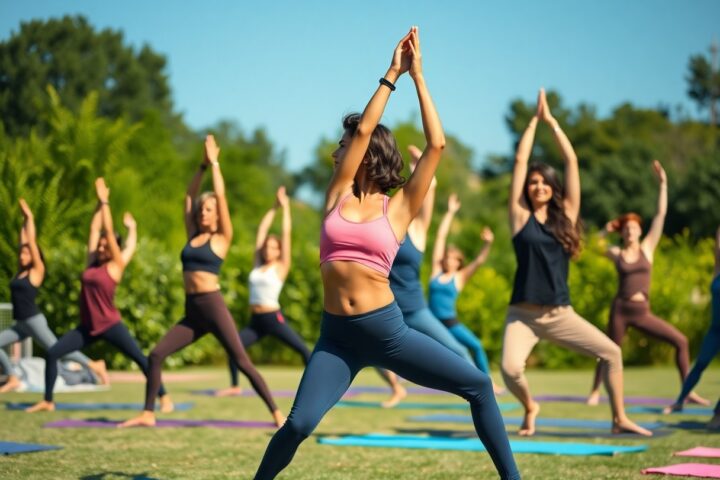Yoga is a powerful practice that can significantly enhance your flexibility and mobility. By incorporating a variety of postures and stretches, you can gradually increase your range of motion, leading to better overall physical performance and reduced risk of injury. As you engage in regular practice, you’ll discover that not only do your muscles become more pliable, but your joints also feel freer and more resilient. In this blog post, you’ll learn specific techniques and benefits of yoga that can help you unlock greater physical potential.
The Science of Flexibility
Your body’s flexibility is influenced by various physiological factors, including muscle elasticity, joint structure, and the nervous system. Understanding these elements can help you improve your mobility and overall physical performance. Flexibility is not simply about stretch; it involves a complex interplay of muscles, tendons, and fascia working together. By practicing yoga, you can tap into these mechanisms, promoting better movement and reducing the likelihood of injury.
Understanding Muscle Elasticity
Around your muscles lies connective tissue that plays a significant role in elasticity. This tissue can stretch and return to its original shape, which determines how flexible you can become. Engaging in regular stretching and yoga practices encourages the elongation of these muscle fibers, improving blood flow and making it easier for your body to move through a wider range of motion.
The Role of Joints in Mobility
Around your joints, structures such as ligaments and cartilage facilitate movement and stability. Healthy joints allow for better mobility, helping you perform daily activities and physical exercises with ease. When joints are well-conditioned, the range of motion increases, making it easier for you to adopt various yoga poses that enhance your overall flexibility.
Another important aspect of joint health is the synovial fluid that lubricates your joints, ensuring smooth movement. Regular yoga practice helps promote this fluid’s production, further supporting joint functionality. By focusing on movements that enhance both flexibility and joint stability, you create a foundation for improved mobility that can serve you well in all aspects of your life.
Yoga Styles That Enhance Flexibility
While various yoga styles exist, some are particularly effective in improving your flexibility and mobility. By engaging in these practices, you can cultivate greater range of motion and deep, restorative stretches that will benefit your body. Two prominent styles to consider are Hatha and Yin Yoga, each offering unique approaches to enhancing your physical abilities.
Hatha Yoga
Across many yoga studios, Hatha Yoga serves as a foundational practice for those seeking to increase physical flexibility. It emphasizes a balanced combination of postures and breath control, allowing you to ease into deeper stretches at your own pace. As you practice Hatha regularly, you’ll likely notice improvements in your overall mobility and alignment.
Yin Yoga
One effective style for enhancing flexibility is Yin Yoga, which focuses on long-held passive poses that target deeper connective tissues in your body. This practice encourages a profound release of tension and promotes greater flexibility over time. By allowing yourself to relax in these extended stretches, you enhance your ability to open up both physically and mentally.
Also, Yin Yoga is distinct in its approach to flexibility; it encourages you to hold poses for several minutes, which allows your muscles to fully relax and your joints to become more pliable. As you experience this deep stretching, you’ll cultivate patience and mindfulness, enhancing not just your physical flexibility but also your overall wellbeing. Regular practice can lead to significant improvements in your range of motion and can complement other forms of exercise you may incorporate into your routine.
Key Poses for Improving Flexibility
Clearly, incorporating specific yoga poses into your routine can significantly enhance your flexibility. The right poses target various muscle groups, promoting lengthening and expansion throughout your body. With consistent practice, you will notice gradual improvements in your range of motion, making daily activities and athletic performance more accessible and enjoyable. Explore these important poses to create a balanced approach to increasing your flexibility.
Forward Bends
After practicing forward bends, you will feel a remarkable release in your hamstrings, calves, and lower back. Forward bends like Paschimottanasana (Seated Forward Bend) and Uttanasana (Standing Forward Bend) help elongate your spine and encourage deep stretches. These poses not only promote flexibility but also create a calming effect on your mind and body, allowing you to connect with your breath while gently pushing your boundaries.
Hip Openers
Around hip openers, you will discover a transformative way to release tension in your lower body. Poses such as Pigeon Pose and Butterfly Pose target tight hips, allowing for greater mobility and flexibility. When you regularly incorporate these poses into your practice, you’ll notice improved alignment, reduced discomfort during movement, and enhanced athletic performance. By dedicating time to hip openers, you’re paving the way for better overall physical wellness.
Bends, twists, and stretches are integral to opening the hips and releasing stored tension. By practicing hip openers like Frog Pose and Lizard Pose, you’re not only developing flexibility but also strengthening the surrounding muscles. Deeply engaging in these poses reduces tightness and discomfort, improving your overall range of motion. Remember to breathe deeply as you flow through these poses, allowing each exhale to release tightness and each inhale to deepen your stretch.
The Benefits of Increased Mobility
Unlike static stretches that only lengthen muscles, improved mobility enhances your joint range of motion, making everyday activities easier and more efficient. This increased mobility allows you to perform various movements with greater ease, from bending down to tie your shoes to reaching overhead for an item on a shelf. By integrating mobility exercises into your routine, you empower yourself to navigate daily tasks with confidence and comfort, ultimately enhancing your quality of life.
Functional Movement in Daily Life
Above all, better mobility translates into functional movement, allowing you to engage in daily activities without restriction. Whether it’s climbing stairs, playing with your kids, or lifting groceries, increased range of motion makes these tasks less challenging. By incorporating yoga into your life, you develop a greater awareness of your body and the way it moves, which can lead to improved performance in almost any physical endeavor.
Injury Prevention
Life is full of activities that put stress on your body, and increased mobility plays a key role in injury prevention. When your joints and muscles are flexible and strong, you are less likely to sustain injuries from falls or overexertion.
For instance, improved mobility allows your muscles and joints to work together more efficiently, reducing the risk of strains and sprains during physical activity. By consistently practicing yoga, you strengthen the muscles that support your joints while increasing their flexibility, ensuring that your body can adapt to various movements. This means that everyday tasks, like lifting or twisting, are less likely to result in injury, allowing you to maintain an active and healthy lifestyle for years to come.
Integrating Yoga into Your Routine
All it takes is a little commitment and creativity to incorporate yoga into your daily life. Start by setting aside specific times for your practice, and choose a space where you feel comfortable and focused. You can integrate short sessions into your morning or evening routine, or combine yoga with other forms of exercise you already do. Whether it’s a dedicated class or a few minutes at home, the key is to make yoga a regular part of your lifestyle for enhanced flexibility and mobility.
Establishing a Consistent Practice
By prioritizing consistency in your practice, you will begin to notice significant increases in flexibility and mobility. Aim for shorter daily sessions rather than infrequent longer ones, as frequent practice helps your body adapt more effectively. Create a schedule that fits your lifestyle and allows for gradual progression over time.
Tips for Beginners
For those starting their yoga journey, focus on building a foundation that suits your needs. Here are some helpful tips to ease you into the practice:
- Start with beginner-friendly classes or online resources.
- Listen to your body and take breaks when needed.
- Use props like blocks and straps for support.
- Practice regularly, even for just a few minutes daily.
Knowing these vitals will help you create a sustainable and enjoyable practice that enhances your flexibility.
Understanding your limitations and exploring various yoga styles can greatly benefit beginners. Experiment with different types of yoga, such as Hatha, Vinyasa, or Yin, to discover what resonates with you. Don’t hesitate to ask instructors for adjustments or modifications suited to your level. Creating a supportive environment can also make your practice more enjoyable:
- Find a local studio or community group to practice with.
- Try practicing at home with guided videos.
- Set personal goals to keep yourself motivated.
Knowing these strategies will facilitate a more rewarding yoga experience as you improve your flexibility and mobility.
Common Challenges in Developing Flexibility
Many people encounter various challenges when striving to improve their flexibility. Factors such as muscle tension, lack of consistency in practice, and previous injuries can hinder your progress. Additionally, unrealistic expectations regarding the rate of improvement may lead to frustration. Understanding these challenges can help you navigate your flexibility journey more effectively and maintain motivation as you grow.
Overcoming Mental Barriers
One of the most significant obstacles you may face is your own mindset. Self-doubt, impatience, and fear of injury can create mental barriers that prevent you from fully engaging in your practice. Trusting your body and focusing on gradual improvements rather than immediate results will help you overcome these hurdles and enhance your flexibility.
Physical Limitations and Progression
Physical limitations often play a role in flexibility development. Factors such as muscle tightness, joint stiffness, and anatomical differences can affect your ability to achieve various poses. It’s imperative to set realistic goals and work at a pace that suits your body to foster progress gradually.
In fact, acknowledging your physical limitations is key to creating a sustainable progression plan. By learning to listen to your body and understanding its unique needs, you can implement modifications and incorporate alternative stretches that target specific areas. This tailored approach not only helps avoid injuries but also promotes steady growth in flexibility, allowing you to build confidence and enjoy your yoga practice more fully.
Conclusion
Upon reflecting, you can see how yoga significantly enhances your flexibility and mobility. By incorporating various poses into your routine, you gradually lengthen your muscles and improve joint function. This practice not only promotes physical well-being but also contributes to injury prevention and overall balance in your body. As you commit to yoga, you will likely notice increased range of motion and ease in your daily activities, ultimately leading to a more active and fulfilling lifestyle.



